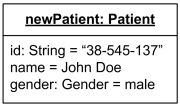UML Object
In all versions of UML from UML 1.x to UML 2.5, the essence of object is the same:
Object is an instance of a class.
Glossary of the now obsolete UML 1.4.2 Specification defined object as
An entity with a well defined boundary and identity that encapsulates state and behavior. State is represented by attributes and relationships, behavior is represented by operations, methods, and state machines. An object is an instance of a class.
UML 2.5 describes object as
An object is an individual [thing] with a state and relationships to other objects. The state of an object identifies the values for that object of properties of the classifier of the object.
Class may be modeled as being active, meaning that an instance of the class has some autonomous behavior.
Though object is a basic UML concept, there is no corresponding UML element. Objects are rendered as instance specifications, usually on object diagrams. So when we see instance of a class, we can call it object.

Customer class instance without name,
anonymous object.
In some cases, class of an instance is either unknown or not specified.

An instance named newPatient
of some unnamed or unknown class.
If instance name is also not provided, the notation for such an anonymous instance of an unnamed classifier is simply underlined colon - :.
An object could have all of instance name, class, and namespace (package) specified.

Object front-facing-cam of the Camera class
from android.hardware package.
If an instance has some value, value specification could be shown either after an equal sign ('=') following the instance name, or below the name without the equal sign.

Instance orderPaid of the Date class
has value July 31, 2011 3:00 pm.
Object slots are shown as structural features with the feature name followed by an equal sign ('=') and a value specification. Type (classifier) of the feature could be also shown.

Instance newPatient of the Patient class
has slots with values specified.